Maybe it’s because I miss the great food in St. Barth so much, but since I got back I’ve been eating out like crazy. With treats like pork belly at Pulino’s or Kobe at BLT Steak, it’s been a dizzying couple weeks of rich and naughty foods that have left me feeling in need of a food detox. So what better way to right the ship than with a nice 8 course meal? There is a catch of course, in that the meal was at Kajitsu, a vegetarian restaurant. Yes, you read that right- I voluntarily went to a vegetarian restaurant! But with raves from two of the impeccable palates over at Dudes On Foods, including one review when Ferran Adria was in the house, I was pretty confident that I was going to enjoy myself despite the lack of meat.
I was seated at the bar where I would have a great front row seat to observe Chef Masato Nishihara apply his craft. If you’ve been to the dessert bar Chikalicious, the scene will feel familiar. You can tell that a lot of intricate preparation had been done well before service as you observe the trays and tupperware containers the chef pulls out of the lowboy refrigerator containing all kinds of savory gelees, pristine vegetables, and a thrilling variety of fascinating edible garnishes. Chef Nishihara assembles each dish with a deft touch and an eye for aesthetics. The whole concept behind Kajitsu is shojin cuisine, which I understand to be the culinary embodiment of Zen Buddhist ideals. So it really isn’t just about fresh seasonal ingredients. Things like the lighting, the scent of the restaurant and the beauty of the pottery all play a role in the dining experience. There’s definitely an element of culture integrated into every aspect, and that’s a big reason why a dinner at Kajitsu feels like so much more than just a meal.
The first course was this chilled white asparagus with cucumber, green yuzu and almonds:

The flavor was a lot more delicate than the dish looks because that mound of green sauce over the asparagus is, I believe, grated Japanese cucumber. The first word that comes to mind is fresh. The mild herbaceous quality of the sauce made it seem so alive, and yet it didn’t overwhelm the subtle flavor of the asparagus. To add a more assertive flavor component, this candied green plum with plum gelee was served alongside:
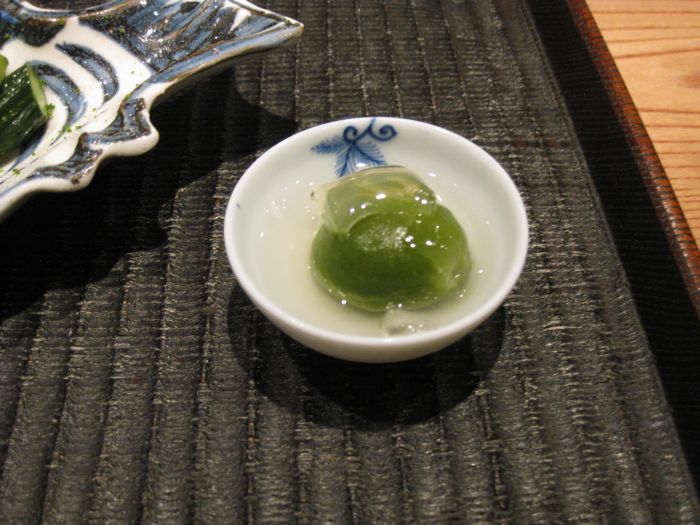
The plum gelee is just like something you’d expect at Chikalicious. It was so bright in flavor but not overly sweet. The plum itself was softer in texture than I expected. Ok, it was actually mushy, but that just made it easier to squeeze the pit out. I really enjoyed the plum but found it kind of an unusual accompaniment to the asparagus because you couldn’t really eat them together. The plum for me was more of a palate cleanser.
Next was the soup course. Here is the red miso soup with grilled eggplaint:
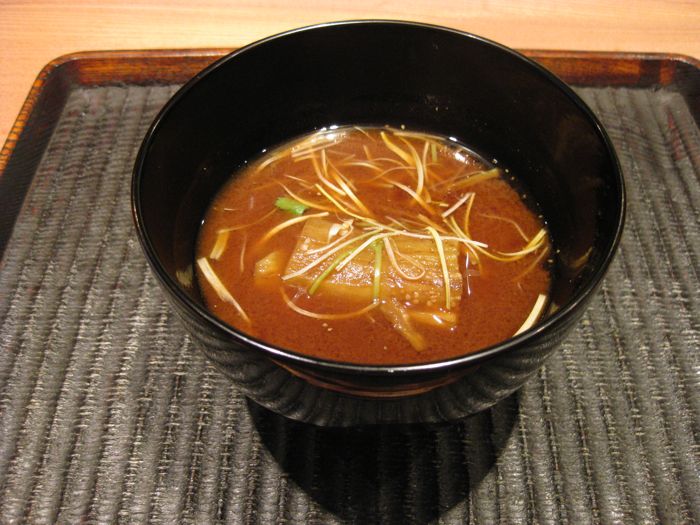
While it was nearly 90 degrees in NY, this hot soup was still a very welcome course. The eggplant you see in the middle is actually a little bundle of eggplant pieces tied together with a thread of mitsuba. The miso broth was deep and earthy and no, it wasn’t too salty. It was a soul satisfying soup, the kind that you sip slowly as you serenely contemplate on life. Yeah, I think there was some sort of Zen thing starting to happen and Chef Nishihara’s food was the catalyst.
Next up, a mountain yam and azuki bean cake with grilled baby corn and a cup of parsley root soup:
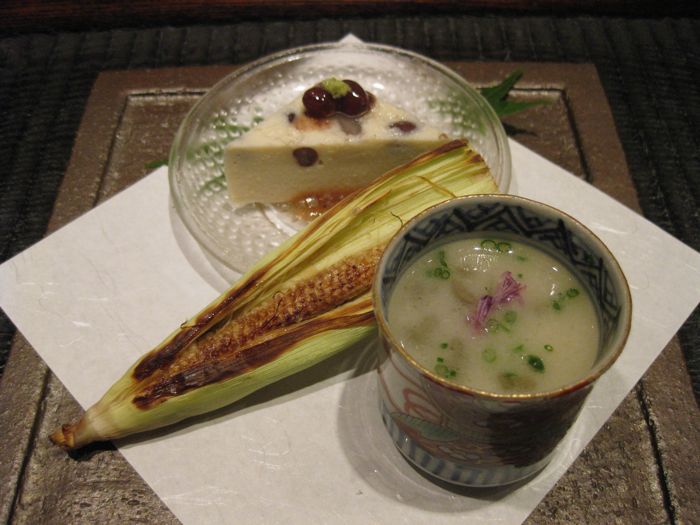
The cake was the texture of a cheesecake but had an extremely subtle savory flavor to it. It was definitely more of a delicate textural pleasure than a taste bud dazzler. The big flavor came from the grilled baby corn. The first taste sensation was the gentle toastiness from the grilling but as I continued chewing, the brilliant flavor of corn just burst through. Imagine that, corn that tastes like corn! It’s like I was just reminded of what the flavor of corn really is. Fantastic. The parsley root soup was also a wonder. Mainly I was wondering how the heck the broth could possibly taste that good without any animal product! It had an almost milky mouth feel to it which usually you only get from broths made from marrow bones. Whatever this chef is doing, it’s pretty special.
Next I was served the noodle course, a soba in chilled broth:
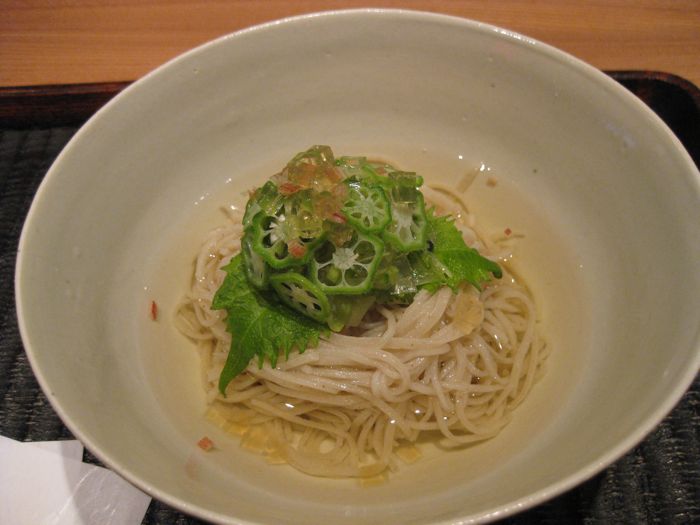
Yes, those are fine slices of okra you see! There was a lot more going on in this dish than it appears. Those little reddish specks floating in the broth are super finely diced bits of miyoga, sort of a mild herbaceous oniony vegetable, one of my favorite Japanese ingredients. In addition, you can clearly see a shiso leaf and the oh so amazing tiny cubes of white soy gelee on top. I tasted a bit of the gelee on its own to see if it might be really salty, but of course it wasn’t. Nothing about any of the courses at Kajitsu is ever out of balance. What you can’t make out in the photo is that there was also jicama, shishito pepper, a hint of ginger and a paper thin slice of peeled lemon. The lemon was soft in texture and bright on the palate without being too assertively sour. It was a surprisingly awesome match with the soba. Just brilliant.
But to really have balance, you gotta have a little something fried to go with all this healthy stuff, don’t you? Of course you do, so here was Kajitsu’s tempura course:
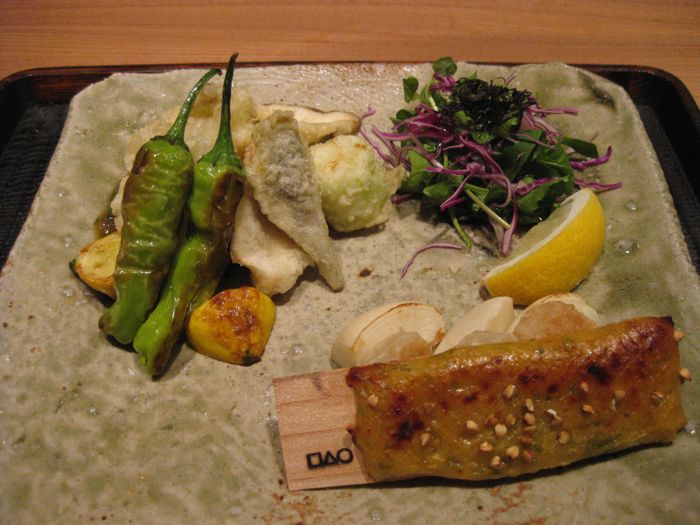
The tempura veggies were porcini mushrooms and cabbage. As you can probably guess, they were perfect- crispy while being impossibly light and not at all greasy. With them are simply grilled shishito peppers and pattypan squash. The stuff on the wooden stick is a seasoned miso paste which has been lightly grilled. You’re supposed to scrape off a bit of the miso and eat it with the grilled turnip and nama-fu pieces you see behind the stick. I’m not exactly sure what the miso was seasoned with but I was getting almost floral and citrusy notes from it. Mysterious and delicious.
The next course looked kind of boring on the menu, but it turned out to be my favorite. More or less just a simple bowl of rice:
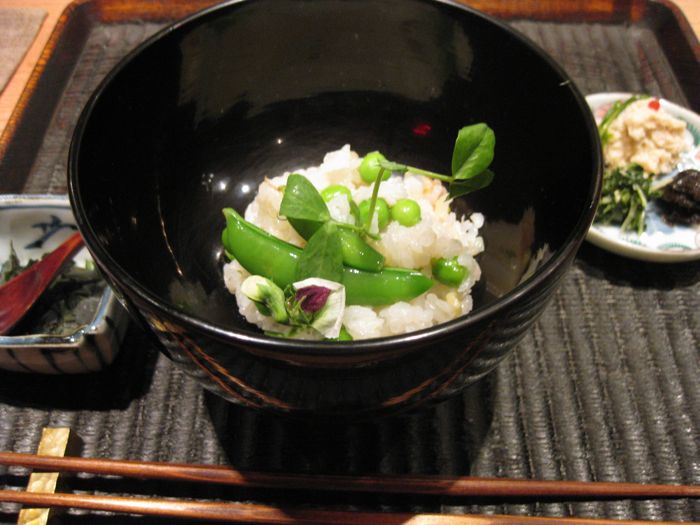
Yes, it really is just rice with a few peas. For garnish there’s a little dish of dried wakame seaweed flakes which you can sprinkle over the top, plus you get a little dish of Japanese pickles. I find it hard to explain why this dish was my favorite, but it just was. The rice was moister than you’d expect and sticky enough to pick up in clumps with chopsticks. The peas were naturally perfectly cooked, tender but still with a satisfying crispness and a gentle sweetness. The wakame flakes added just enough salt to animate every mouthful. Nothing in each element would seem to wow you, but when eaten together, the textures and flavors are so fulfilling. And that’s a very interesting thing about this meal- even without meat, I felt completely satisfied. In fact this was the point in my meal where it dawned on me that I hadn’t even thought about meat the entire time. And to take it a step further, at that moment I viscerally understood why meat was not a part of this type of cuisine. I just can’t imagine any meat dish being this elegant and capturing this level of subtle, almost mystical refinement and spirituality. I think I was starting to get what Jose Andres meant in a recent 60 Minutes when he said that meat is overrated and that fruits and vegetables are what’s really sexy. Don’t get me wrong, I’m a raging carnivore for life, but I feel like I have now seen a level of grace and sophistication from this meal that just wouldn’t be possible with any menu containing animal protein. It just seems that any plate with meat on it is going to appear clumsy and oafish in comparison to the kind of food that Kajitsu is serving. I know it sounds crazy, but that’s really what I was thinking as I was enjoying that magnificent bowl of rice.
To end the meal was a simple red bean jelly, two finely crafted Japanese candies and a cup of Schincha green tea:
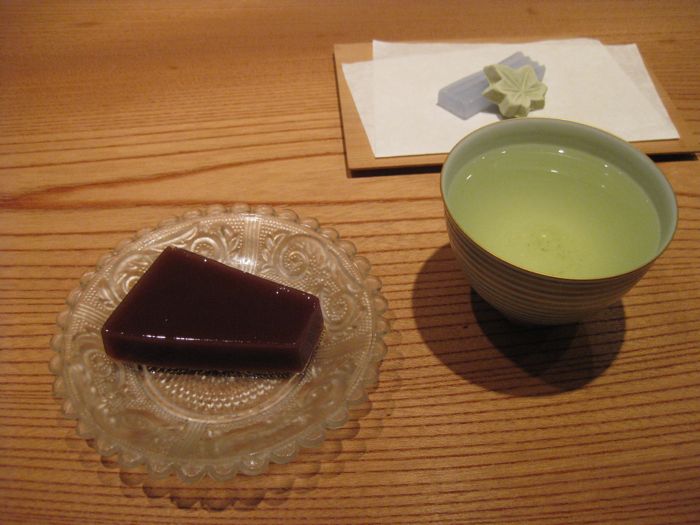
Like most Asian desserts, the red bean jelly wasn’t too sweet. But for those of you who do like a sugar charge at the end of a meal, the candies by Kyoto Suetomi might do the trick. Very elegant and refined, just like the rest of the meal.
I should point out that this meal wasn’t cheap, at $70 for the 8 course menu (a 4 course menu is also available for $50), plus $34 if you opt for the sake pairings. So you’re probably thinking “$70 for vegetables?!” But come on, that works out to less than $9 per course! That’s more than reasonable for the quality and variety of ingredients and the incredible finesse and care that goes into each preparation.
It’s hard not being a little self-conscious as you take in an experience like this. The stuff is so obviously on another level you can’t help but question yourself. Do you like it because it really is great? Or is it that if you don’t like it then it reflects poorly on your level of taste and sophistication because you can’t appreciate it? This is what I imagine it would be like to go to the opera and actually enjoying it. That’s what was running through my mind as I started the meal, as I observed how meticulously every detail was executed. Not just the work going into the food, but the flawless yet unobtrusive service, the selection of plates, bowls and sake glasses, even the way the little slivers of paper used as coasters were folded in a very precise manner. Was I going to like this opera because I’m supposed to? Well, the true measure of the success of Kajitsu is that by somewhere around the third course, I was no longer the self-conscious observer; I was completely in the moment and fully engaged in the experience. And by the time I had that transcendent bowl of rice, I think I was pretty much in another world.
I can see why when I saw you afterwards and I asked about the meal that you needed time to process it. It sounds like it was not just physical but a spiritual and mental experience as well. Sounds fantastic. Been meaning to try it.
Too bad the baby shower, yoga and Chinese soup was keeping me busy that day.
Seasoned wakame was awesome. 🙂
Great pics and post!